MAPKAPK-2-mediated LIM-kinase activation is critical for VEGF-induced actin remodeling and cell migration
- PMID: 16456544
- PMCID: PMC1383554
- DOI: 10.1038/sj.emboj.7600973
MAPKAPK-2-mediated LIM-kinase activation is critical for VEGF-induced actin remodeling and cell migration
Abstract
Vascular endothelial growth factor-A (VEGF-A) induces actin reorganization and migration of endothelial cells through a p38 mitogen-activated protein kinase (MAPK) pathway. LIM-kinase 1 (LIMK1) induces actin remodeling by phosphorylating and inactivating cofilin, an actin-depolymerizing factor. In this study, we demonstrate that activation of LIMK1 by MAPKAPK-2 (MK2; a downstream kinase of p38 MAPK) represents a novel signaling pathway in VEGF-A-induced cell migration. VEGF-A induced LIMK1 activation and cofilin phosphorylation, and this was inhibited by the p38 MAPK inhibitor SB203580. Although p38 phosphorylated LIMK1 at Ser-310, it failed to activate LIMK1 directly; however, MK2 activated LIMK1 by phosphorylation at Ser-323. Expression of a Ser-323-non-phosphorylatable mutant of LIMK1 suppressed VEGF-A-induced stress fiber formation and cell migration; however, expression of a Ser-323-phosphorylation-mimic mutant enhanced these processes. Knockdown of MK2 by siRNA suppressed VEGF-A-induced LIMK1 activation, stress fiber formation, and cell migration. Expression of kinase-dead LIMK1 suppressed VEGF-A-induced tubule formation. These findings suggest that MK2-mediated LIMK1 phosphorylation/activation plays an essential role in VEGF-A-induced actin reorganization, migration, and tubule formation of endothelial cells.
Figures
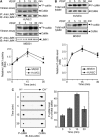

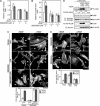
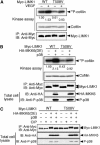

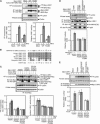
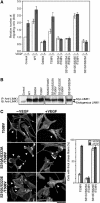
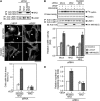
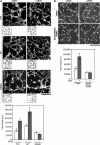
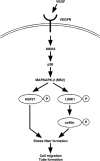
Similar articles
-
Specific activation of LIM kinase 2 via phosphorylation of threonine 505 by ROCK, a Rho-dependent protein kinase.J Biol Chem. 2001 Jan 5;276(1):670-6. doi: 10.1074/jbc.M007074200. J Biol Chem. 2001. PMID: 11018042
-
p38 MAP kinase activation by vascular endothelial growth factor mediates actin reorganization and cell migration in human endothelial cells.Oncogene. 1997 Oct;15(18):2169-77. doi: 10.1038/sj.onc.1201380. Oncogene. 1997. PMID: 9393975
-
Regulation of vascular endothelial growth factor-induced endothelial cell migration by LIM kinase 1-mediated phosphorylation of annexin 1.J Biol Chem. 2010 Mar 12;285(11):8013-21. doi: 10.1074/jbc.M109.098665. Epub 2010 Jan 8. J Biol Chem. 2010. PMID: 20061392 Free PMC article.
-
The Role of LIM Kinase in the Male Urogenital System.Cells. 2021 Dec 28;11(1):78. doi: 10.3390/cells11010078. Cells. 2021. PMID: 35011645 Free PMC article. Review.
-
Mitogen-activated protein kinase-activated protein kinase 2 in neuroinflammation, heat shock protein 27 phosphorylation, and cell cycle: role and targeting.Mol Pharmacol. 2014 Feb;85(2):345-56. doi: 10.1124/mol.113.090365. Epub 2013 Dec 2. Mol Pharmacol. 2014. PMID: 24296859 Review.
Cited by
-
Sulfamoylated Estradiol Analogs Targeting the Actin and Microtubule Cytoskeletons Demonstrate Anti-Cancer Properties In Vitro and In Ovo.Cancers (Basel). 2024 Aug 23;16(17):2941. doi: 10.3390/cancers16172941. Cancers (Basel). 2024. PMID: 39272798 Free PMC article.
-
Isolation and characterization of the TIGA genes, whose transcripts are induced by growth arrest.Nucleic Acids Res. 2006;34(17):4878-92. doi: 10.1093/nar/gkl651. Epub 2006 Sep 14. Nucleic Acids Res. 2006. PMID: 16973895 Free PMC article.
-
Extracellular Pgk1 interacts neural membrane protein enolase-2 to improve the neurite outgrowth of motor neurons.Commun Biol. 2023 Aug 15;6(1):849. doi: 10.1038/s42003-023-05223-0. Commun Biol. 2023. PMID: 37582937 Free PMC article.
-
Mitogen-activated protein kinase-activated protein kinase-2 (MK2) and its role in cell survival, inflammatory signaling, and migration in promoting cancer.Mol Carcinog. 2022 Feb;61(2):173-199. doi: 10.1002/mc.23348. Epub 2021 Sep 24. Mol Carcinog. 2022. PMID: 34559922 Free PMC article.
-
The Snail signaling branch downstream of the TGF-β/Smad3 pathway mediates Rho activation and subsequent stress fiber formation.J Biol Chem. 2024 Jan;300(1):105580. doi: 10.1016/j.jbc.2023.105580. Epub 2023 Dec 21. J Biol Chem. 2024. PMID: 38141763 Free PMC article.
References
-
- Arber S, Barbayannis FA, Hanser H, Schneider C, Stayon CA, Bernard O, Caroni P (1998) Regulation of actin dynamics through phosphorylation of cofilin by LIM-kinase. Nature 393: 805–809 - PubMed
-
- Ashida N, Arai H, Yamasaki M, Kita T (2001) Distinct signaling pathways for MCP-1-dependent integrin activation and chemotaxis. J Biol Chem 276: 16555–16560 - PubMed
-
- Bamburg JR, Wiggan OP (2002) ADF/cofilin and actin dynamics in disease. Trends Cell Biol 12: 598–605 - PubMed
-
- Brummelkamp TR, Bernards R, Agami R (2002) A system for stable expression of short interfering RNAs in mammalian cells. Science 296: 550–553 - PubMed
-
- Dawe HR, Minamide LS, Bamburg JR, Cramer LP (2003) ADF/cofilin controls cell polarity during fibroblast migration. Curr Biol 13: 252–257 - PubMed
Publication types
MeSH terms
Substances
LinkOut - more resources
Full Text Sources
Other Literature Sources
Molecular Biology Databases

